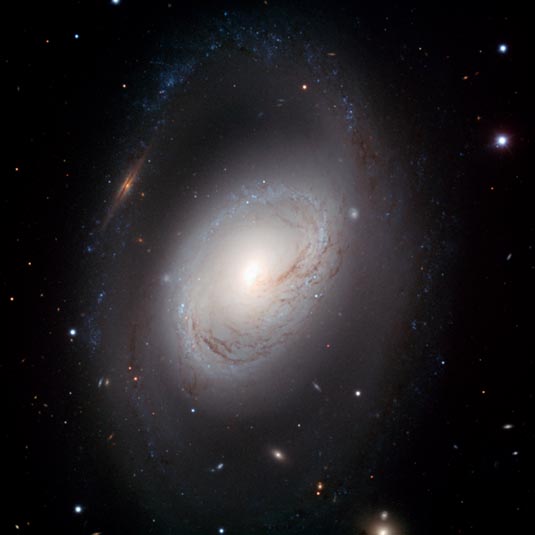
Description: Spiral Galaxy
Position (J2000): RA 10h 46m 45.76s Dec 11° 49' 11.96"
Constellation: Leo
Distance: 35 million light years
Apparent Magnitude: 10.1
Apparent dimensions: 7.6' × 5.2'
Field of view: 6.83 x 6.83 arcminutes
Orientation: North is 0.1° right of vertical
Image Credit: ESO/Oleg Maliy
Release date: October 24, 2011
2015 image
ABOUT THIS IMAGE:
Not all spiral galaxies have to be picture-perfect to be striking. Messier 96, also known as NGC 3368, is a case in point: its core is displaced from the center, its gas and dust are distributed asymmetrically and its spiral arms are ill-defined. But this portrait, taken with the FORS1 instrument on ESO's Very Large Telescope, shows that imperfection is beauty in Messier 96. The galaxy's core is compact but glowing, and the dark dust lanes around it move in a delicate swirl towards the nucleus. And the spiral arms, patchy rings of young blue stars, are like necklaces of blue pearls.
Messier 96 lies in the constellation of Leo (The Lion). It is the largest galaxy in the Leo I group of galaxies; including its outermost spiral arms, it spans some 100 000 light-years in diameter - about the size of our Milky Way. Its graceful imperfections likely result from the gravitational pull of other members in the group, or are perhaps due to past galactic encounters.
A multitude of background galaxies peers through the dusty spiral. Perhaps the most striking of these objects is an edge-on galaxy that - because of a chance alignment - appears to interrupt the outermost spiral arm to the upper left of Messier 96's core.
This
image was processed by ESO using the observational data found by Oleg
Maliy from Ukraine, who participated in ESO's Hidden Treasures 2010 astrophotography
competition, organized in October-November 2010, for everyone who enjoys
making beautiful images of the night sky using astronomical data obtained
with professional telescopes. To find out more about Hidden Treasures,
visit http://www.eso.org/public/outreach/hiddentreasures/.
From Wikipedia:
Messier 96 (also known as M96 or NGC 3368) is an intermediate spiral galaxy about 31 million light-years away in the constellation Leo. It was discovered by French astronomer Pierre Méchain on March 20, 1781. After communicating his finding, French astronomer Charles Messier confirmed the finding four days later and added it to his catalogue of nebulous objects. Finding this object is extremely difficult with binoculars. With a 10" telescope, the galaxy is visible as a 3 × 5 arcminute halo with a brighter core region.
This complex galaxy is inclined by an angle of about 53° to the line of sight from the Earth, which is oriented at a position angle of 172°. It is categorized as a double-barred spiral galaxy with a small inner bulge through the core along with an outer bulge. The nucleus displays a weak level of activity of the LINER2 type. Variations in ultraviolet emission from the core suggest the presence of a super massive black hole. Estimates for the mass of this object range from 1.5×106 to 4.8×107 times the mass of the Sun.
On May 9, 1998 a supernova event was observed in this galaxy. Designated SN 1998bu, this was a Type Ia supernova explosion. It reached maximum light on May 21 then steadily declined in magnitude thereafter. Observations of the ejecta a year later showed that the explosion created 0.4 times the mass of the Sun worth of iron. The spectrum of the supernova remnant confirmed the presence of radioactive 56Co, which decays into 56Fe.
M96
is the brightest galaxy within the M96 Group, a group of galaxies in the
constellation Leo that includes the Messier objects M95 and M105, as well
as at least nine other galaxies. The M96 galaxy has asymmetric arms and
a displaced core, probably caused by the gravitational pull by the other
nearby galaxies.